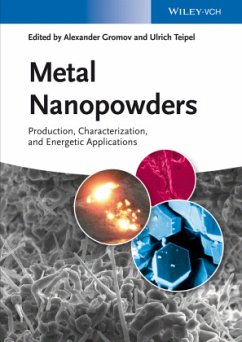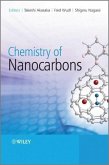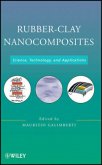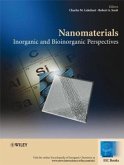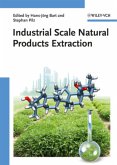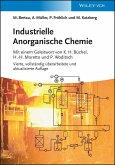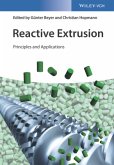Metal Nanopowders
Production, Characterization, and Energetic Applications
Herausgegeben von Gromov, Alexander; Teipel, Ulrich
Metal Nanopowders
Production, Characterization, and Energetic Applications
Herausgegeben von Gromov, Alexander; Teipel, Ulrich
- Gebundenes Buch
- Merkliste
- Auf die Merkliste
- Bewerten Bewerten
- Teilen
- Produkt teilen
- Produkterinnerung
- Produkterinnerung
Written with both postgraduate students and researchers in academia and industry in mind, this reference covers the chemistry behind metal nanopowders, including production, characterization, oxidation and combustion. The contributions from renowned international scientists working in the field detail applications in technologies, scale-up processes and safety aspects surrounding their handling and storage.
Andere Kunden interessierten sich auch für
![Chemistry of Nanocarbons Chemistry of Nanocarbons]() Chemistry of Nanocarbons164,99 €
Chemistry of Nanocarbons164,99 €![Rubber-Clay Nanocomposites Rubber-Clay Nanocomposites]() Rubber-Clay Nanocomposites198,99 €
Rubber-Clay Nanocomposites198,99 €![Nanomaterials Nanomaterials]() Nanomaterials415,99 €
Nanomaterials415,99 €![Industrial Crystallization Process Monitoring and Control Industrial Crystallization Process Monitoring and Control]() Industrial Crystallization Process Monitoring and Control140,99 €
Industrial Crystallization Process Monitoring and Control140,99 €![Industrial Scale Natural Products Extraction Industrial Scale Natural Products Extraction]() Industrial Scale Natural Products Extraction154,99 €
Industrial Scale Natural Products Extraction154,99 €![Industrielle Anorganische Chemie Industrielle Anorganische Chemie]() Martin BertauIndustrielle Anorganische Chemie139,00 €
Martin BertauIndustrielle Anorganische Chemie139,00 €![Reactive Extrusion Reactive Extrusion]() Reactive Extrusion143,99 €
Reactive Extrusion143,99 €-
-
-
Written with both postgraduate students and researchers in academia and industry in mind, this reference covers the chemistry behind metal nanopowders, including production, characterization, oxidation and combustion. The contributions from renowned international scientists working in the field detail applications in technologies, scale-up processes and safety aspects surrounding their handling and storage.
Hinweis: Dieser Artikel kann nur an eine deutsche Lieferadresse ausgeliefert werden.
Hinweis: Dieser Artikel kann nur an eine deutsche Lieferadresse ausgeliefert werden.
Produktdetails
- Produktdetails
- Verlag: Wiley-VCH
- 1. Auflage
- Seitenzahl: 440
- Erscheinungstermin: Juni 2014
- Englisch
- Abmessung: 247mm x 173mm x 26mm
- Gewicht: 1084g
- ISBN-13: 9783527333615
- ISBN-10: 3527333614
- Artikelnr.: 39736013
- Verlag: Wiley-VCH
- 1. Auflage
- Seitenzahl: 440
- Erscheinungstermin: Juni 2014
- Englisch
- Abmessung: 247mm x 173mm x 26mm
- Gewicht: 1084g
- ISBN-13: 9783527333615
- ISBN-10: 3527333614
- Artikelnr.: 39736013
Alexander Gromov obtained his academic degrees from Bijsk Technologic Institute (1998, Chem.Eng.) and Tomsk Polytechnic University (2000, PhD), before working for Tomsk Polytechnic University (Russia), University of Ulsan (South Korea), Forschungszentrum Karlsruhe and Fraunhofer Institute of Chemical Technology (Germany), Milan Polytechnic University (Italy). He was a visiting professor at the Aerospace Engineering Department at Milan Polytechnic University (Italy), 2011-2013 before obtaining the Humboldt Grant for Experienced Researchers and moving to Nuremberg Technical University George-Simon Ohm (Germany) in 2013. Professor Gromov has authored over 150 scientific publications and several books and has received numerous Russian scientific awards, including the Russian Academy of Science Medal in 2009. He is also a member of the International Award Committee of the "Global Energy Prize".
Ulrich Teipel studied Mechanical Engineering at the University of Applied Science of Münster, Germany, 1977 to 1981, followed by Chemical Engineering and Fluid Mechanics at the Technical University (RWTH) of Aachen, Germany, from 1983 to 1990. From 1991 on, he worked as a Research Scientist at the Fraunhofer Institute of Chemical Technology (ICT), becoming Leader of the research group Particle Technology and Deputy Head of the department Energetic Materials in 1996. Since 2004 he has been a Professor of Particle Technology, Mechanical Process Engineering and Fluidmechanics at the Nuremberg Technical University George-Simon Ohm, Germany. His research focuses on R&D on the product design and characterization of particulate materials. Within the field of Particle Technology he is involved in communition, sieve classification, raw materials, mineral processing, rheology of complex fluids and the characterization of particles and disperse systems. Prof. Teipel is a Member of the German Society of Crystallization and Communition and Classification.
Ulrich Teipel studied Mechanical Engineering at the University of Applied Science of Münster, Germany, 1977 to 1981, followed by Chemical Engineering and Fluid Mechanics at the Technical University (RWTH) of Aachen, Germany, from 1983 to 1990. From 1991 on, he worked as a Research Scientist at the Fraunhofer Institute of Chemical Technology (ICT), becoming Leader of the research group Particle Technology and Deputy Head of the department Energetic Materials in 1996. Since 2004 he has been a Professor of Particle Technology, Mechanical Process Engineering and Fluidmechanics at the Nuremberg Technical University George-Simon Ohm, Germany. His research focuses on R&D on the product design and characterization of particulate materials. Within the field of Particle Technology he is involved in communition, sieve classification, raw materials, mineral processing, rheology of complex fluids and the characterization of particles and disperse systems. Prof. Teipel is a Member of the German Society of Crystallization and Communition and Classification.
Foreword
Introduction
ESTIMATION OF THERMODYNAMIC DATA OF METALLIC NANOPARTICLES BASED ON BULK VALUES
Introduction
Thermodynamic Background
Size-Dependent Materials Data of Nanoparticles
Comparison of Experimental and Calculated Melting Temperatures
Comparision with Data for the Entropy of Melting
Discusson of the Results
Conclusions
Appendix
NUMERICAL SIMULATION OF INDIVIDUAL METALLIC NANOPARTICLES
Introduction
Molecular Dynamics Simulation
Size-Dependent Properties
Sintering Study of Two Nanoparticles
Oxidation of Nanoparticles in the Presence of Oxygen
Heating and Cooling of a Core-Shell Structured Particle
Chapter Summary
ELECTROEXPLOSIVE NANOMETALS
Introduction
Electrical Explosion of Wires Technology for Nanometals Production
Conclusion
METAL NANOPOWDERS PRODUCTION
Introduction
EEW Method of Nanopowder Production
Recondensation NP-Producing Methods: Plasma-Based Technology
Characteristics of Al Nanopowders
Nanopowder Chemical Passivation
Microencapsulation of Al Nanoparticles
The Process of Producing Nanopowders of Aluminum by Plasma-Based Technology
CHARACTERIZATION OF METALLIC NANOPARTICLE AGGLOMERATES
Introduction
Description of the Structure of Nanoparticle Agglomerates
Experimental Techniques to Characterize the Agglomerate Structure
Mechanical Stability
Thermal Stability
Rate-Limiting Steps: Gas Transport versus Reaction Velocity
Conclusions
PASSIVATION OF METAL NANOPOWDERS
Introduction
Theoretical and Experimental Background
Characteristics of the Passivated Particles
Conclusion
SAFETY ASPECTS OF METAL NANOPOWDERS
Introduction
Some Basic Phenomena of Oxidation of Nanometal Particles in Air
Determination of Fire Hazards of Nanopowders
Sensitivity against Electrostatic Discharge
Ranking of Nanopowders According to Hazard Classification
Demands for Packing
REACTION OF ALUMINUM POWDERS WITH LIQUID WATER AND STEAM
Introduction
Experimental Technique for Studying Reaction Al Powders with Liquid and Gaseous Water
Oxidation of Aluminum Powder in Water Vapor Flow
Nanopowders Passivated with Coatings on the Base of Aluminum Carbide
Study of Al Powder/H2O Slurry Samples Heated Linear in "Open System" by STA
Ultrasound (US) and Chemical Activation of Metal Aluminum Oxidation in Liquid Water
Conclusion
NANOSIZED COBALT CATALYSTS FOR HYDROGEN STORAGE SYSTEMS BASED ON AMMONIA BORANE AND SODIUM BOROHYDRIDE
Introduction
A Study of Nanosized Cobalt Borides by Physicochemical Methods
Conclusions
REACTIVE AND METASTABLE NANOMATERIALS PREPARED BY MECHANICAL MILLING
Introduction
Mechanical Milling Equipment
Process Parameters
Material Characterization
Ignition and Combustion Experiments
Starting Materials
Mechanically Alloyed and Metal-Metal Composite Powders
Reactive Nanocomposite Powders
Conclusions
CHARACTERIZING METAL PARTICLE COMBUSTION IN SITU: NON-EQUILIBRIUM DIAGNOSTICS
Introduction
Ignition and Combustion of Solid Materials
Aluminum Reaction Mechanisms
The Flame Tube
Flame Temperature
Conclusions
CHARACTERIZATION AND COMBUSTION OF ALUMINUM NANOPOWDERS IN ENERGETIC SYSTEMS
Fuels in Energetic Systems: Introduction and Literature Survey
Thermochemical Performance of Energetic Additives
Nanosized Powder Characterization
Mechanical and Rheological Behavior with Nanopowders
Combustion of Nanopowders in Solid Propellants and Fuels
Index
Introduction
ESTIMATION OF THERMODYNAMIC DATA OF METALLIC NANOPARTICLES BASED ON BULK VALUES
Introduction
Thermodynamic Background
Size-Dependent Materials Data of Nanoparticles
Comparison of Experimental and Calculated Melting Temperatures
Comparision with Data for the Entropy of Melting
Discusson of the Results
Conclusions
Appendix
NUMERICAL SIMULATION OF INDIVIDUAL METALLIC NANOPARTICLES
Introduction
Molecular Dynamics Simulation
Size-Dependent Properties
Sintering Study of Two Nanoparticles
Oxidation of Nanoparticles in the Presence of Oxygen
Heating and Cooling of a Core-Shell Structured Particle
Chapter Summary
ELECTROEXPLOSIVE NANOMETALS
Introduction
Electrical Explosion of Wires Technology for Nanometals Production
Conclusion
METAL NANOPOWDERS PRODUCTION
Introduction
EEW Method of Nanopowder Production
Recondensation NP-Producing Methods: Plasma-Based Technology
Characteristics of Al Nanopowders
Nanopowder Chemical Passivation
Microencapsulation of Al Nanoparticles
The Process of Producing Nanopowders of Aluminum by Plasma-Based Technology
CHARACTERIZATION OF METALLIC NANOPARTICLE AGGLOMERATES
Introduction
Description of the Structure of Nanoparticle Agglomerates
Experimental Techniques to Characterize the Agglomerate Structure
Mechanical Stability
Thermal Stability
Rate-Limiting Steps: Gas Transport versus Reaction Velocity
Conclusions
PASSIVATION OF METAL NANOPOWDERS
Introduction
Theoretical and Experimental Background
Characteristics of the Passivated Particles
Conclusion
SAFETY ASPECTS OF METAL NANOPOWDERS
Introduction
Some Basic Phenomena of Oxidation of Nanometal Particles in Air
Determination of Fire Hazards of Nanopowders
Sensitivity against Electrostatic Discharge
Ranking of Nanopowders According to Hazard Classification
Demands for Packing
REACTION OF ALUMINUM POWDERS WITH LIQUID WATER AND STEAM
Introduction
Experimental Technique for Studying Reaction Al Powders with Liquid and Gaseous Water
Oxidation of Aluminum Powder in Water Vapor Flow
Nanopowders Passivated with Coatings on the Base of Aluminum Carbide
Study of Al Powder/H2O Slurry Samples Heated Linear in "Open System" by STA
Ultrasound (US) and Chemical Activation of Metal Aluminum Oxidation in Liquid Water
Conclusion
NANOSIZED COBALT CATALYSTS FOR HYDROGEN STORAGE SYSTEMS BASED ON AMMONIA BORANE AND SODIUM BOROHYDRIDE
Introduction
A Study of Nanosized Cobalt Borides by Physicochemical Methods
Conclusions
REACTIVE AND METASTABLE NANOMATERIALS PREPARED BY MECHANICAL MILLING
Introduction
Mechanical Milling Equipment
Process Parameters
Material Characterization
Ignition and Combustion Experiments
Starting Materials
Mechanically Alloyed and Metal-Metal Composite Powders
Reactive Nanocomposite Powders
Conclusions
CHARACTERIZING METAL PARTICLE COMBUSTION IN SITU: NON-EQUILIBRIUM DIAGNOSTICS
Introduction
Ignition and Combustion of Solid Materials
Aluminum Reaction Mechanisms
The Flame Tube
Flame Temperature
Conclusions
CHARACTERIZATION AND COMBUSTION OF ALUMINUM NANOPOWDERS IN ENERGETIC SYSTEMS
Fuels in Energetic Systems: Introduction and Literature Survey
Thermochemical Performance of Energetic Additives
Nanosized Powder Characterization
Mechanical and Rheological Behavior with Nanopowders
Combustion of Nanopowders in Solid Propellants and Fuels
Index
Foreword
Introduction
ESTIMATION OF THERMODYNAMIC DATA OF METALLIC NANOPARTICLES BASED ON BULK VALUES
Introduction
Thermodynamic Background
Size-Dependent Materials Data of Nanoparticles
Comparison of Experimental and Calculated Melting Temperatures
Comparision with Data for the Entropy of Melting
Discusson of the Results
Conclusions
Appendix
NUMERICAL SIMULATION OF INDIVIDUAL METALLIC NANOPARTICLES
Introduction
Molecular Dynamics Simulation
Size-Dependent Properties
Sintering Study of Two Nanoparticles
Oxidation of Nanoparticles in the Presence of Oxygen
Heating and Cooling of a Core-Shell Structured Particle
Chapter Summary
ELECTROEXPLOSIVE NANOMETALS
Introduction
Electrical Explosion of Wires Technology for Nanometals Production
Conclusion
METAL NANOPOWDERS PRODUCTION
Introduction
EEW Method of Nanopowder Production
Recondensation NP-Producing Methods: Plasma-Based Technology
Characteristics of Al Nanopowders
Nanopowder Chemical Passivation
Microencapsulation of Al Nanoparticles
The Process of Producing Nanopowders of Aluminum by Plasma-Based Technology
CHARACTERIZATION OF METALLIC NANOPARTICLE AGGLOMERATES
Introduction
Description of the Structure of Nanoparticle Agglomerates
Experimental Techniques to Characterize the Agglomerate Structure
Mechanical Stability
Thermal Stability
Rate-Limiting Steps: Gas Transport versus Reaction Velocity
Conclusions
PASSIVATION OF METAL NANOPOWDERS
Introduction
Theoretical and Experimental Background
Characteristics of the Passivated Particles
Conclusion
SAFETY ASPECTS OF METAL NANOPOWDERS
Introduction
Some Basic Phenomena of Oxidation of Nanometal Particles in Air
Determination of Fire Hazards of Nanopowders
Sensitivity against Electrostatic Discharge
Ranking of Nanopowders According to Hazard Classification
Demands for Packing
REACTION OF ALUMINUM POWDERS WITH LIQUID WATER AND STEAM
Introduction
Experimental Technique for Studying Reaction Al Powders with Liquid and Gaseous Water
Oxidation of Aluminum Powder in Water Vapor Flow
Nanopowders Passivated with Coatings on the Base of Aluminum Carbide
Study of Al Powder/H2O Slurry Samples Heated Linear in "Open System" by STA
Ultrasound (US) and Chemical Activation of Metal Aluminum Oxidation in Liquid Water
Conclusion
NANOSIZED COBALT CATALYSTS FOR HYDROGEN STORAGE SYSTEMS BASED ON AMMONIA BORANE AND SODIUM BOROHYDRIDE
Introduction
A Study of Nanosized Cobalt Borides by Physicochemical Methods
Conclusions
REACTIVE AND METASTABLE NANOMATERIALS PREPARED BY MECHANICAL MILLING
Introduction
Mechanical Milling Equipment
Process Parameters
Material Characterization
Ignition and Combustion Experiments
Starting Materials
Mechanically Alloyed and Metal-Metal Composite Powders
Reactive Nanocomposite Powders
Conclusions
CHARACTERIZING METAL PARTICLE COMBUSTION IN SITU: NON-EQUILIBRIUM DIAGNOSTICS
Introduction
Ignition and Combustion of Solid Materials
Aluminum Reaction Mechanisms
The Flame Tube
Flame Temperature
Conclusions
CHARACTERIZATION AND COMBUSTION OF ALUMINUM NANOPOWDERS IN ENERGETIC SYSTEMS
Fuels in Energetic Systems: Introduction and Literature Survey
Thermochemical Performance of Energetic Additives
Nanosized Powder Characterization
Mechanical and Rheological Behavior with Nanopowders
Combustion of Nanopowders in Solid Propellants and Fuels
Index
Introduction
ESTIMATION OF THERMODYNAMIC DATA OF METALLIC NANOPARTICLES BASED ON BULK VALUES
Introduction
Thermodynamic Background
Size-Dependent Materials Data of Nanoparticles
Comparison of Experimental and Calculated Melting Temperatures
Comparision with Data for the Entropy of Melting
Discusson of the Results
Conclusions
Appendix
NUMERICAL SIMULATION OF INDIVIDUAL METALLIC NANOPARTICLES
Introduction
Molecular Dynamics Simulation
Size-Dependent Properties
Sintering Study of Two Nanoparticles
Oxidation of Nanoparticles in the Presence of Oxygen
Heating and Cooling of a Core-Shell Structured Particle
Chapter Summary
ELECTROEXPLOSIVE NANOMETALS
Introduction
Electrical Explosion of Wires Technology for Nanometals Production
Conclusion
METAL NANOPOWDERS PRODUCTION
Introduction
EEW Method of Nanopowder Production
Recondensation NP-Producing Methods: Plasma-Based Technology
Characteristics of Al Nanopowders
Nanopowder Chemical Passivation
Microencapsulation of Al Nanoparticles
The Process of Producing Nanopowders of Aluminum by Plasma-Based Technology
CHARACTERIZATION OF METALLIC NANOPARTICLE AGGLOMERATES
Introduction
Description of the Structure of Nanoparticle Agglomerates
Experimental Techniques to Characterize the Agglomerate Structure
Mechanical Stability
Thermal Stability
Rate-Limiting Steps: Gas Transport versus Reaction Velocity
Conclusions
PASSIVATION OF METAL NANOPOWDERS
Introduction
Theoretical and Experimental Background
Characteristics of the Passivated Particles
Conclusion
SAFETY ASPECTS OF METAL NANOPOWDERS
Introduction
Some Basic Phenomena of Oxidation of Nanometal Particles in Air
Determination of Fire Hazards of Nanopowders
Sensitivity against Electrostatic Discharge
Ranking of Nanopowders According to Hazard Classification
Demands for Packing
REACTION OF ALUMINUM POWDERS WITH LIQUID WATER AND STEAM
Introduction
Experimental Technique for Studying Reaction Al Powders with Liquid and Gaseous Water
Oxidation of Aluminum Powder in Water Vapor Flow
Nanopowders Passivated with Coatings on the Base of Aluminum Carbide
Study of Al Powder/H2O Slurry Samples Heated Linear in "Open System" by STA
Ultrasound (US) and Chemical Activation of Metal Aluminum Oxidation in Liquid Water
Conclusion
NANOSIZED COBALT CATALYSTS FOR HYDROGEN STORAGE SYSTEMS BASED ON AMMONIA BORANE AND SODIUM BOROHYDRIDE
Introduction
A Study of Nanosized Cobalt Borides by Physicochemical Methods
Conclusions
REACTIVE AND METASTABLE NANOMATERIALS PREPARED BY MECHANICAL MILLING
Introduction
Mechanical Milling Equipment
Process Parameters
Material Characterization
Ignition and Combustion Experiments
Starting Materials
Mechanically Alloyed and Metal-Metal Composite Powders
Reactive Nanocomposite Powders
Conclusions
CHARACTERIZING METAL PARTICLE COMBUSTION IN SITU: NON-EQUILIBRIUM DIAGNOSTICS
Introduction
Ignition and Combustion of Solid Materials
Aluminum Reaction Mechanisms
The Flame Tube
Flame Temperature
Conclusions
CHARACTERIZATION AND COMBUSTION OF ALUMINUM NANOPOWDERS IN ENERGETIC SYSTEMS
Fuels in Energetic Systems: Introduction and Literature Survey
Thermochemical Performance of Energetic Additives
Nanosized Powder Characterization
Mechanical and Rheological Behavior with Nanopowders
Combustion of Nanopowders in Solid Propellants and Fuels
Index
